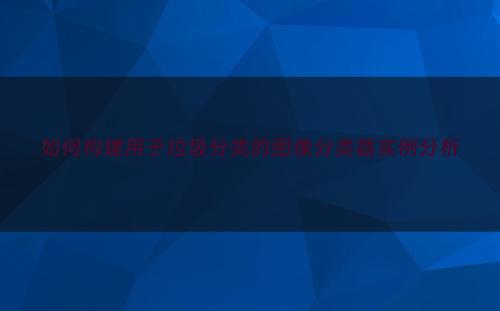在这篇文章中,我将使用fastai库(构建在PyTorch上)训练卷积神经网络,将图像分类为硬纸板、玻璃、金属、纸张、塑料或垃圾。我将使用由Gary Thung和Mindy Yang手工收集的图像数据集。请在此处下载机器学习数据集(https://github.com/garythung/trashnet/blob/master/data/dataset-resized.zip)。注意:您需要使用GPU来加速训练。
导入Python库
from fastai.vision import * from fastai.metrics import error_rate from pathlib import Path from glob2 import glob from sklearn.metrics import confusion_matrix import pandas as pd import numpy as np import os import zipfile as zf import shutil import re import seaborn as sns
提取数据
首先,我们需要提取“dataset-resized.zip”的内容。

files = zf.ZipFile("dataset-resized.zip",'r')
files.extractall()
files.close()
解压缩后,有六子文件夹:
os.listdir(os.path.join(os.getcwd(),"dataset-resized"))
['paper', 'trash', '.DS_Store', 'cardboard', 'metal', 'glass', 'plastic']
将图像组织到不同的文件夹中
现在我们已经提取了数据,我将使用50-25-25分割将图像分割为训练、验证和测试图像文件夹。首先,我需要定义一些辅助函数。
## helper functions ## ## splits indices for a folder into train, validation, and test indices with random sampling ## input: folder path ## output: train, valid, and test indices def split_indices(folder,seed1,seed2): n = len(os.listdir(folder)) full_set = list(range(1,n+1)) ## train indices random.seed(seed1) train = random.sample(list(range(1,n+1)),int(.5*n)) ## temp remain = list(set(full_set)-set(train)) ## separate remaining into validation and test random.seed(seed2) valid = random.sample(remain,int(.5*len(remain))) test = list(set(remain)-set(valid)) return(train,valid,test) ## gets file names for a particular type of trash, given indices ## input: waste category and indices ## output: file names def get_names(waste_type,indices): file_names = [waste_type+str(i)+".jpg" for i in indices] return(file_names) ## moves group of source files to another folder ## input: list of source files and destination folder ## no output def move_files(source_files,destination_folder): for file in source_files: shutil.move(file,destination_folder)
接下来,我将根据ImageNet目录约定创建一组目标文件夹。它看起来是这样的:
每个图像文件只是材质名称和编号(如cardboard1.jpg)
## paths will be train/cardboard, train/glass, etc...
subsets = ['train','valid']
waste_types = ['cardboard','glass','metal','paper','plastic','trash']
## create destination folders for data subset and waste type
for subset in subsets:
for waste_type in waste_types:
folder = os.path.join('data',subset,waste_type)
if not os.path.exists(folder):
os.makedirs(folder)
if not os.path.exists(os.path.join('data','test')):
os.makedirs(os.path.join('data','test'))
## move files to destination folders for each waste type
for waste_type in waste_types:
source_folder = os.path.join('dataset-resized',waste_type)
train_ind, valid_ind, test_ind = split_indices(source_folder,1,1)
## move source files to train
train_names = get_names(waste_type,train_ind)
train_source_files = [os.path.join(source_folder,name) for name in train_names]
train_dest = "data/train/"+waste_type
move_files(train_source_files,train_dest)
## move source files to valid
valid_names = get_names(waste_type,valid_ind)
valid_source_files = [os.path.join(source_folder,name) for name in valid_names]
valid_dest = "data/valid/"+waste_type
move_files(valid_source_files,valid_dest)
## move source files to test
test_names = get_names(waste_type,test_ind)
test_source_files = [os.path.join(source_folder,name) for name in test_names]
## I use data/test here because the images can be mixed up
move_files(test_source_files,"data/test")
为了重现,我将两个随机样本的seed都设置为1。
## get a path to the folder with images path = Path(os.getcwd())/"data" tfms = get_transforms(do_flip=True,flip_vert=True) data = ImageDataBunch.from_folder(path,test="test",ds_tfms=tfms,bs=16)
ImageDataBunch.from_folder()指定我们将从ImageNet结构的文件夹中提取我们的训练,验证和测试数据。批量大小bs是您一次训练的图像数量。如果计算机内存较少,请选择较小的batch size。您可以使用get_transforms()函数来增强数据。
以下是数据的示例:
data.show_batch(rows=4,figsize=(10,8))
机器学习模型训练
learn = create_cnn(data,models.resnet34,metrics=error_rate)
什么是resnet34?
残差神经网络是一个多层卷积神经网络(CNN)。resnet34有34层,是在ImageNet数据库上预训练好的。预训练的卷积神经网络(CNN)将在新的图像分类任务中表现得更好,因为它已经学习了一些视觉特征,并且可以将这些知识进行转移(从而转移学习)。
由于深度神经网络能够描述更多的复杂性,因此理论上它应该比浅层神经网络在训练数据上表现得更好。
创建了Resnets以使用称为快捷方式连接的黑客来规避这个故障。如果图层中的某些节点具有次优值,则可以调整权重和偏差; 如果节点是最优的(其残差为0),为什么不单独留下?仅根据需要对节点进行调整(当存在非零残差时)。
需要调整时,快捷方式连接应用标识功能将信息传递给后续层。这在可能的情况下缩短了神经网络,并允许resnet具有深层体系结构,并且更像浅层神经网络。resnet34中的34只是指层数。
找到学习率
我将找到梯度下降的学习率,以确保我的神经网络合理快速收敛。
learn.lr_find(start_lr=1e-6,end_lr=1e1) learn.recorder.plot()
学习率查找器建议学习率为5.13e-03。
训练机器学习模型
learn.fit_one_cycle(20,max_lr=5.13e-03)
模型运行了20个epochs。这种拟合方法最酷的地方在于,学习率随着时间的推移而降低,使我们越来越接近最优值。8.6%的验证误差看起来非常好,让我们看看它在测试数据上是如何执行的。
首先,我们可以看看哪些图片分类最不正确。
可视化大多数不正确的图像
interp = ClassificationInterpretation.from_learner(learn) losses,idxs = interp.top_losses() interp.plot_top_losses(9, figsize=(15,11))
看起来这些照片曝光太多,所以这实际上并不是机器学习模型的错!
doc(interp.plot_top_losses) interp.plot_confusion_matrix(figsize=(12,12), dpi=60)
机器学习模型常常把塑料和玻璃混淆,把金属和玻璃混淆。最令人困惑的图片如下
interp.most_confused(min_val=2)
对测试数据做出预测
要了解此机器学习模式的实际执行情况,我们需要对测试数据进行预测。首先,我将使用learner.get_preds()方法对测试数据进行预测。
注意: learner.predict()仅预测单个图像,而learner.get_preds()预测一组图像。
preds = learn.get_preds(ds_type=DatasetType.Test)
get_preds(ds_type)中的ds_type参数采用DataSet参数。示例值是DataSet.Train,DataSet.Valid和DataSet.Test。
print(preds[0].shape) preds[0]
这些是每个图像的预测概率。这个张量有365行(每幅图像-行)和6列(每一种材料类别一列)。
data.classes
['cardboard', 'glass', 'metal', 'paper', 'plastic', 'trash']
把上面张量中的概率转换成一个带有类名的字符串。
## saves the index (0 to 5) of most likely (max) predicted class for each image max_idxs = np.asarray(np.argmax(preds[0],axis=1)) yhat = [] for max_idx in max_idxs: yhat.append(data.classes[max_idx])
让我们检查第一张图像是否真的是玻璃。
learn.data.test_ds[0][0]
接下来,我将从测试数据集中获得实际的标签。
y = []
## convert POSIX paths to string first
for label_path in data.test_ds.items:
y.append(str(label_path))
## then extract waste type from file path
pattern = re.compile("([a-z]+)[0-9]+")
for i in range(len(y)):
y[i] = pattern.search(y[i]).group(1)
快速检查
## predicted values print(yhat[0:5]) ## actual values print(y[0:5])
看起来前五个预测是一致的!(检查)。同样,我们可以用混淆矩阵来找出答案。
混淆矩阵
cm = confusion_matrix(y,yhat) df_cm = pd.DataFrame(cm,waste_types,waste_types) plt.figure(figsize=(10,8)) sns.heatmap(df_cm,annot=True,fmt="d",cmap="YlGnBu")
同样,这个模型似乎混淆了金属与玻璃的关系和塑料与玻璃的关系。
correct = 0 for r in range(len(cm)): for c in range(len(cm)): if (r==c): correct += cm[r,c] accuracy = correct/sum(sum(cm)) accuracy
0.9212598425196851
最终在测试数据上获得了92.1%的准确度,这非常棒 - TrashNet数据集的原始创建者在70-30测试训练拆分中使用支持向量机实现了63%的测试精度。
最后
建议从数据集中删除过度曝光的照片。这只是一个快速的小项目,它展示了训练一个图像分类模型是非常快的。
